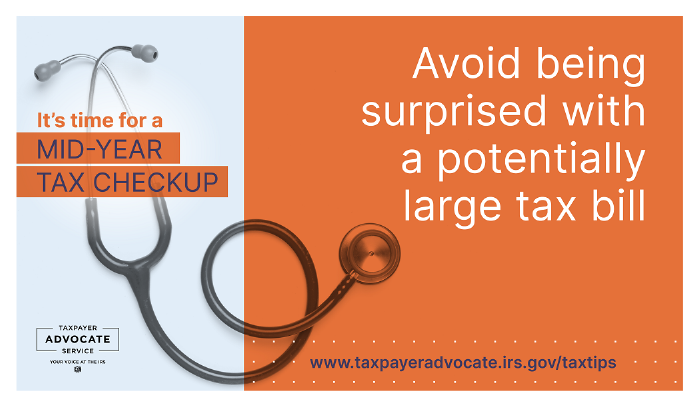View Notice Online:
View your federal tax records and manage your communication preferences online
Sign in to your Online Account to:
- Make payments
- Go paperless for certain notices
- Get email notifications for new notices

Summertime is the perfect time for a mid-year tax checkup. A tax checkup will help you avoid being surprised with a potentially large tax bill and may help uncover ways you can save throughout the rest of the year. It is also a good time to account for any life changes that may affect your overall tax liability.
Pay close attention to your paystubs to help prevent end of year surprises. Make sure the earnings are correct and that you have the proper amount of tax withheld. As time passes, life events like marriage, divorce, having a child, buying a home, or a change in income may affect your taxes. The IRS’s Tax Withholding Estimator will help you assess your income tax, credits, adjustments, and deductions, and determine whether you need to change your tax withholding. If a change is recommended, the estimator will provide instructions to update your withholding with your employer either online or by submitting a new Form W-4, Employee’s Withholding Allowance Certificate.
Remember, most income is taxable. This includes the following sources:
If you receive a substantial amount of non-wage income like self-employment income, investment income, taxable Social Security benefits, or pension and annuity income, you should make quarterly estimated tax payments. Log in to your online account or go to IRS.gov to make a payment online.
Review contributions to your retirement plan, such as 401(k) and Individual Retirement Accounts (IRAs). If you want to maximize your contributions, run the numbers to see how much you need to save from your remaining paychecks this year. Increasing pre-tax retirement contributions reduces your taxable income for the year in which you contribute.
If you have health insurance through your state’s health insurance marketplace established under the Affordable Care Act, it is important to report changes that may affect your premiums. Changes in circumstances to report to the marketplace include:
If you want to see how a change of circumstance might affect your Premium Tax Credit (PTC), you can use the PTC Change Estimator. Remember to contact your marketplace to report a change of circumstances.
Check the balance of your flexible spending arrangement (FSA). FSAs allow you to put some of your pre-tax income toward qualifying medical, dental, and vision expenses, along with other health-related products and services.
While there are some provisions that may let your roll over some money into the next year, most FSAs are “use-or-lose.” Start thinking now about how you might use remaining funds in the second half of the year to ensure you don’t lose the money you contributed to your FSA account.
For more updates from the Taxpayer Advocate Service, visit the news and information center to read the latest tax tips, blogs, alerts and more. Also available in Spanish.